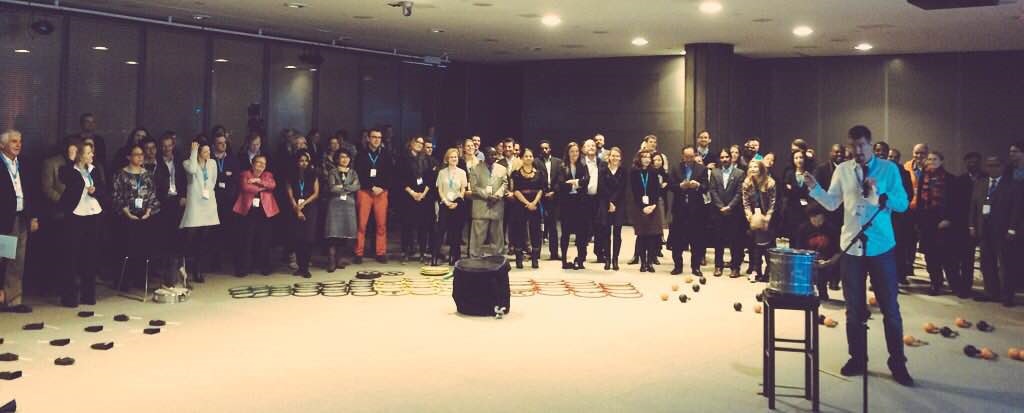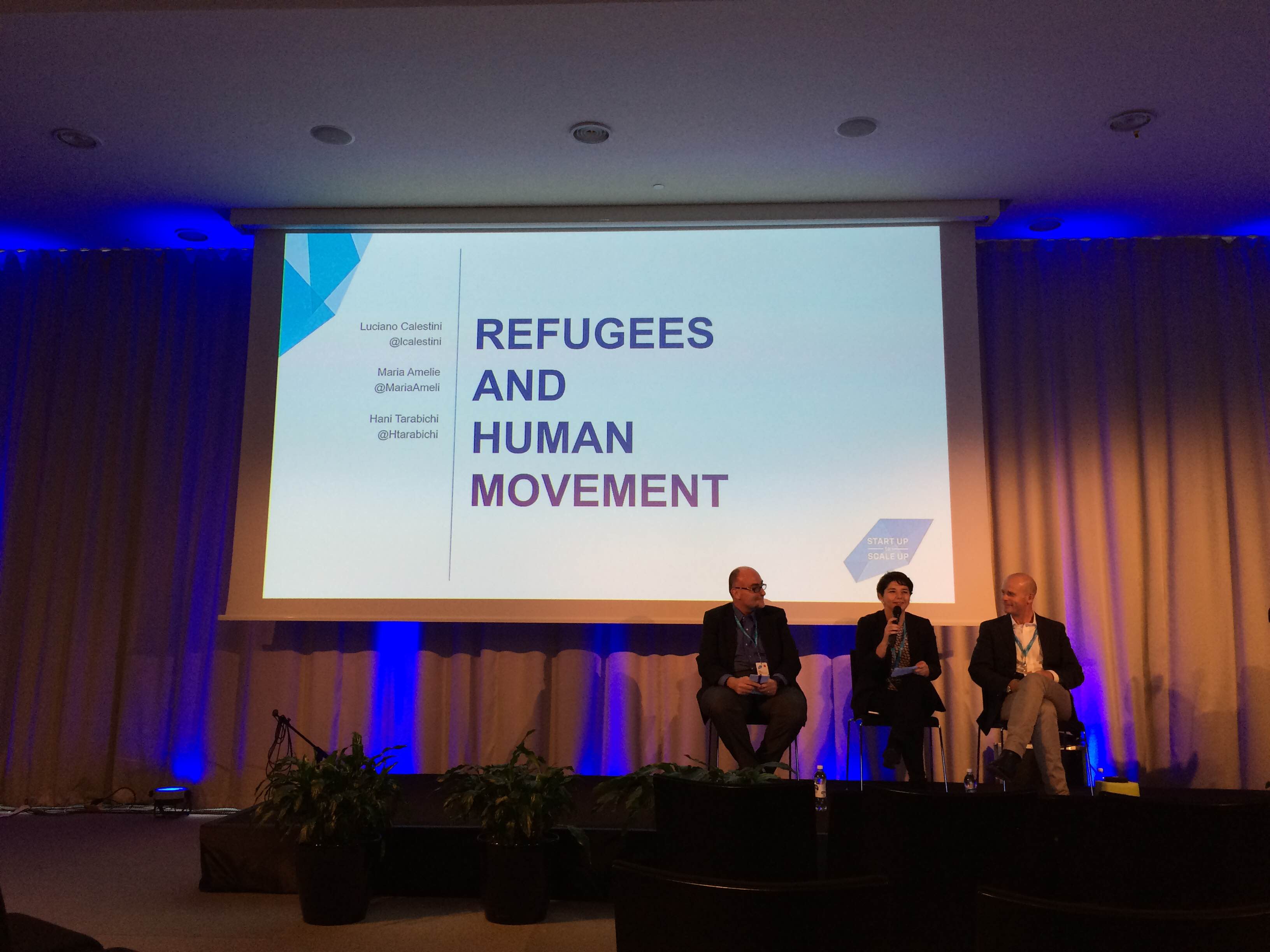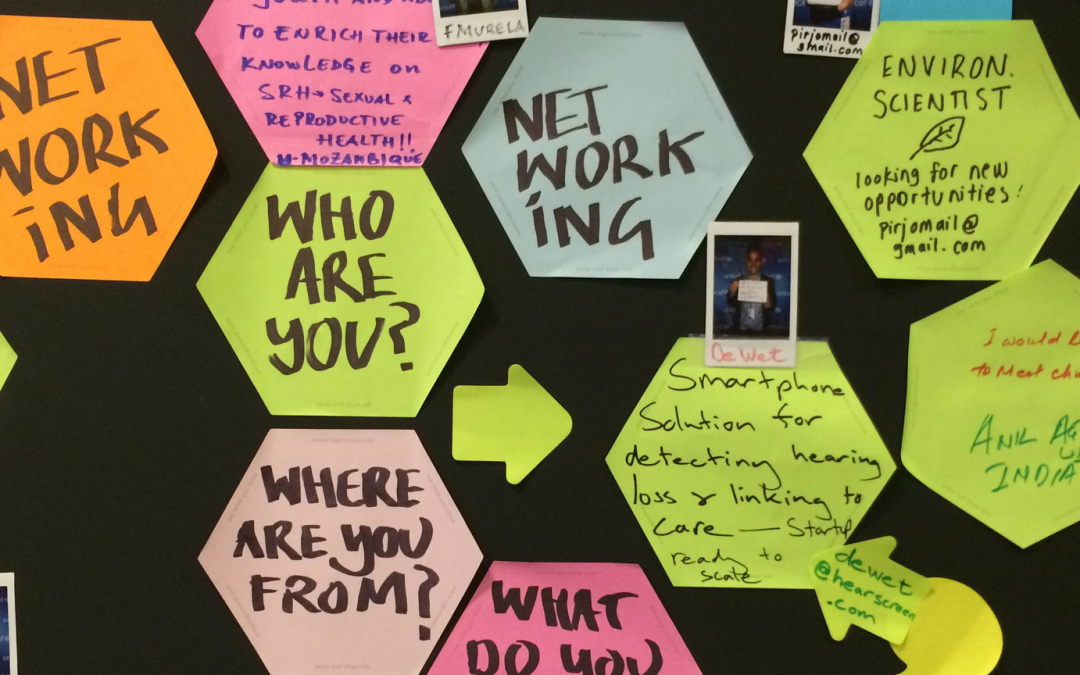UNHCR Innovation had the pleasure of attending the Global Innovations for Children and Youth Summit – ‘Start-Up to Scale-Up; hosted by UNICEF and Finland’s Ministry for Foreign Affairs last week. This wonderful event brought together 400 of UNICEF’s friends, and what Chris Fabian, UNICEF Innovation Co-lead, described as “unusual suspects” to talk about taking startup to scale and reflect on what the future holds for Children and Youth.
UNHCR has held several of its own Education & Innovation convening events over the past several years – from JAMs to Bootcamps – and so I know that any event with the word “innovation” is often met with high expectations and some degree of initial cynicism.
For one, there is often an expectation that an “innovation event” will be different from a traditional conference, providing enhanced opportunities to network and learn about cutting edge-practices and programs.
But are these expectations often met?
How can conveners design gatherings to meet our innovation expectations?
This Summit surpassed my expectations, which is hard to do.
In light of this, I thought it would be helpful to reflect on what UNICEF did well, and suggest 7 things that anyone planning an Innovation summit should consider:

1) Bring together the right people
This is probably the most important and the hardest part of any gathering. This Summit was invite-only and targeted a diverse range of actors: not just those working in the development or humanitarian space, but also scientists, filmmakers, the private sector, and others.
UNICEF ensured they had the right amount of “the choir” present; enough to keep the energy positive and the language common. But then they looked for the outliers who could provide unique perspectives and ask provocative questions.
NASA shared some unique perspectives during their session on their approaches to Innovation, which highlighted important lessons that could be applied to humanitarian innovators. In particular they highlighted:
- The importance of simplifying complex challenges to encourage engagement from diverse stakeholders. For example NASA’s use of cartoons to engage children in the process of space exploration.
- Innovation doesn’t have to happen rapidly. This was demonstrated through a 2015 mission approved for Jupiter that won’t be completed until 2030 because of the preparation required.
- Spinoff outcomes/solutions are an important part of the innovation process. Over 1700 technologies have evolved from NASA inventions; including everything from the digital camera to heart pumps.
2) Keep it dynamic
UNICEF didn’t leave this to chance. They brought in the professionals. RedZebra was hired to ensure that an inviting enabling environment was created; and they crafted this beautifully through shared musical moments.
The opening session set the tone (no-pun intended) with a simple, non-invasive request for the audience to join together with banging the colour tubes that sat on their chairs. This started subtly, but as people’s defenses started to drop, and a unified rhythm started to rise through the crowd’s beats, the mass soon gave way to hip swaying, cheering and an audible bond had formed between the 400-some crowd as we created something together. I mean, talk about a way to launch a summit!
It ended just as brilliantly. This time participants encircled a performance space; nestled together, clutching musical instruments and eagerly awaiting dance-cues from the RedZebra crew, who choreographed a memorable musical finally. All of this inspired from an earlier musical performance from a colleague in Nepal and a Spoken-Word performance from a colleague from Sierra Leone.
It was a beautiful culmination of the past two days and a genuine celebration of the people, the talent, and the aims that united those participating.
3) Remove the formalities
5 minutes into the introduction, Chris Fabian invited people to remove their ties. A joke for some, but an informal setting makes for an inviting environment for innovation.
By removing the connotations of the formal – the business as usual – the summit provided a setting in which hierarchies were removed and everyone – be it CEO, director, or student – could engage on an equal footing. Everyone’s thoughts and opinions were listened to and encouraged.
Removing formalities wasn’t just about eliminating hierarchies.t was also about changing the state of play; pushing people to move outside their regular norms of professional interactions. They say the “Ah-Ha Moments” usually come during casual encounters – drinks, lunch breaks, or the ranting we can only do with friends. By removing the formalities,the Summit simulated, and stimulated, these “friendly forums” for creativity.
The success in removing the formalities was achieved through the details. They didn’t have an agenda; they had a “game plan”. They didn’t impress with fancy food; they opted for the delicious and nutritious. In fact, the first lunch, was based on the Finnish free-school meal program, with primary students picking their favourite for us to try. It was a cheesy casserole with Ketchup, and I must admit it was good.
All of these details paid off,reinforcing the inviting atmosphere that enabled people to connect and collaborate.
4) Foster the right type of networking
While this does relate to the ‘no-formalities’ approach, there were details in the Summit program that enabled everyone to highlight his/her background and interest, without the standard round of introductions. This was largely facilitated through a visual wall display, which included photos, twitter handles, and written highlights for each individual.
There was also plenty of downtime, or rather time to mingle. Participants didn’t feel rushed to immediately head to the next session; there were well-timed breaks for those who wanted to continue the conversations or start new ones. Summit organizers also included time and a physical location during the last session for those who just needed extra time to discuss.
The panelists and organizers also set an important tone. Rather than rush off stage or leave early, they participated in the Summit and were present at every coffee break, chatting with the group.
5) Inspire through storytelling
A constant theme throughout the Summit was the importance of the narrative in all aspects of the innovation process. There was a lively and youthful panel on Day 2, that debated the current development narratives and the importance of who tells the story.
While discourse and debates on “The Other,” “Poverty Porn,” or “True Meaning of Authenticity” are certainly not new, I was captivated because this session was communicated through personal narratives. Each panelist was a storyteller who beautifully articulated his/her point-of-view through lived experiences, all the while politely (yet engagingly) challenging others.
The most inspiring session I attended included two panelists. Maria Amelie, a journalist, who claimed her voice and identity by sharing her story of searching for asylum in Finland; and Hani Tarabichi, a professor who taught entrepreneurship in Syrian and shared his journey about finding his way back into the classroom. Both stories were told from the heart, but had clear messages for the audience to walk away with.
Two particular learning points from this session were:
- The importance of education in providing hope and opportunities for the future. Both Maria and Hani were able to develop communities through educational institutions that helped them develop a sense of belonging as well as enabled them to foster and utilize practical skills to contribute to their new communities.
- An interesting correlation (highlighted by Maria) between the ethos of entrepreneurs and refugees – suggesting that refugees make great entrepreneurs because of:
- Their inherent resilience – refugees focus largely on the present and know that they are responsible for affecting change to their situation;
- Their perspective – refugees’ ‘normal’ is often in flux, which affords them a unique vantage point of common situations; and
- The diversity of their community and individual experiences.
(For more information on this latter point, stay tuned for a potential new book from Maria)
The most important takeaway from this session was that sharing messages in the form of a narrative not only makes a point resoundingly clear, but they make them memorable. Allowing others to not only be inspired, but to also to take these stories and important messages forward.

6) Be daring and adaptive
Not everything at the conference worked, or worked perfectly. The team put a lot of faith in the facilitators and presenters and, for the most part, it paid off.
They also dared to test a new app to inform and register participants for the parallel sessions – a tool that only really worked 70% of the time.
Partners were also daring, putting their projects and their interim results up for a “dragons-den” style review. During which, to put it kindly, they were provided with brutal feedback.
The biggest takeaways from this session were the importance of designing for sustainability from the start and not assuming that it could be built into your program model as the initiative grows. And secondly, identifying the right indicators that enable you to evaluate progress of your main program objectives. Inaccurate or poorly-articulated indicators can result in a seemingly poor program evaluation, even if your initiative is meeting its goals.
All and all, the UNICEF team was very frank about trying new things, and were open to embracing feedback and adapting the program on the fly. Not an easy task, but brilliantly executed.
7) Design for data
From the start, UNICEF knew they wanted to design ways that they could track people’s interactions to later reflect on how to improve. The app (both in success and failure) provided the team with a wealth of data on which profiles were most viewed, which panels were best attended, etc. They also actively captured Twitter data to identify the “tweetable” moments, the questions raised, and general feedback on the summit.
By initially thinking about designing for data, and implementing tools throughout the Summit for tracking behavior; the team has a rich sum of data that can be leveraged to improve future summits! (And yes, UNICEF that is a hint… we are hoping for future ‘Start-Up to Scale-Up’ summits.)
I felt that the Scale-Up aspect of this Summit only scratched the surface, with the majority of advice on “How to scale small” or “How to scale” being focused more on initiating pilots with potential for scale – more than on the scaling itself.
Perhaps the reason for this is there are still a lot of unknowns. Questions like:
What are the real enabling factors that can provide a conducive environment for scale? What inhibits projects from effectively scaling? What determines the sizing of scale, and when should this be determined?
are questions that UNHCR, UNICEF, and DFID have been wrestling with for years. This is part of the reason why at the Summit we launched the first Humanitarian Education Accelerator, that aims to help us understand how to transform good pilot projects into scalable education initiatives.
We hope that by developing a cohort of successful humanitarian innovators, we will be able to identify effective methods to scale education programs to expand quality educational access to refugees and displaced communities worldwide.
If you have an education-in-emergencies innovation, which has already been tested and demonstrates impact, and is now in the process of scaling – we invite you to apply to be part of the first cohort.
Applications are accepted until February 15th 2016.
Submit your application here: www.he-accelerator.org
We’re always looking for great stories, ideas, and opinions on innovations that are led by or create impact for refugees. If you have one to share with us send us an email at [email protected]
If you’d like to repost this article on your website, please see our reposting policy.

